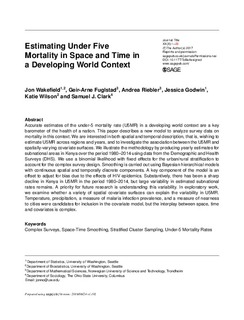| dc.contributor.author | Wakefield, Jon | |
| dc.contributor.author | Fuglstad, Geir-Arne | |
| dc.contributor.author | Riebler, Andrea Ingeborg | |
| dc.contributor.author | Godwin, Jessica | |
| dc.contributor.author | Wilson, Katie | |
| dc.contributor.author | Clark, Samuel J. | |
| dc.date.accessioned | 2019-03-28T14:12:45Z | |
| dc.date.available | 2019-03-28T14:12:45Z | |
| dc.date.created | 2018-04-22T13:48:43Z | |
| dc.date.issued | 2018 | |
| dc.identifier.citation | Statistical Methods in Medical Research. 2018, . | nb_NO |
| dc.identifier.issn | 0962-2802 | |
| dc.identifier.uri | http://hdl.handle.net/11250/2592274 | |
| dc.description.abstract | Accurate estimates of the under-five mortality rate in a developing world context are a key barometer of the health of a nation. This paper describes a new model to analyze survey data on mortality in this context. We are interested in both spatial and temporal description, that is wishing to estimate under-five mortality rate across regions and years and to investigate the association between the under-five mortality rate and spatially varying covariate surfaces. We illustrate the methodology by producing yearly estimates for subnational areas in Kenya over the period 1980–2014 using data from the Demographic and Health Surveys, which use stratified cluster sampling. We use a binomial likelihood with fixed effects for the urban/rural strata and random effects for the clustering to account for the complex survey design. Smoothing is carried out using Bayesian hierarchical models with continuous spatial and temporally discrete components. A key component of the model is an offset to adjust for bias due to the effects of HIV epidemics. Substantively, there has been a sharp decline in Kenya in the under-five mortality rate in the period 1980–2014, but large variability in estimated subnational rates remains. A priority for future research is understanding this variability. In exploratory work, we examine whether a variety of spatial covariate surfaces can explain the variability in under-five mortality rate. Temperature, precipitation, a measure of malaria infection prevalence, and a measure of nearness to cities were candidates for inclusion in the covariate model, but the interplay between space, time, and covariates is complex. | nb_NO |
| dc.language.iso | eng | nb_NO |
| dc.publisher | SAGE Publications | nb_NO |
| dc.title | Estimating under-five mortality in space and time in a developing world context | nb_NO |
| dc.type | Journal article | nb_NO |
| dc.type | Peer reviewed | nb_NO |
| dc.description.version | acceptedVersion | nb_NO |
| dc.source.pagenumber | 21 | nb_NO |
| dc.source.journal | Statistical Methods in Medical Research | nb_NO |
| dc.identifier.doi | 10.1177/0962280218767988 | |
| dc.identifier.cristin | 1580858 | |
| dc.relation.project | Norges forskningsråd: 240873 | nb_NO |
| dc.description.localcode | © 2018. This is the authors' accepted and refereed manuscript to the article. The final authenticated version is available online at: https://doi.org/10.1177%2F0962280218767988 | nb_NO |
| cristin.unitcode | 194,63,15,0 | |
| cristin.unitname | Institutt for matematiske fag | |
| cristin.ispublished | false | |
| cristin.fulltext | postprint | |
| cristin.qualitycode | 1 | |
